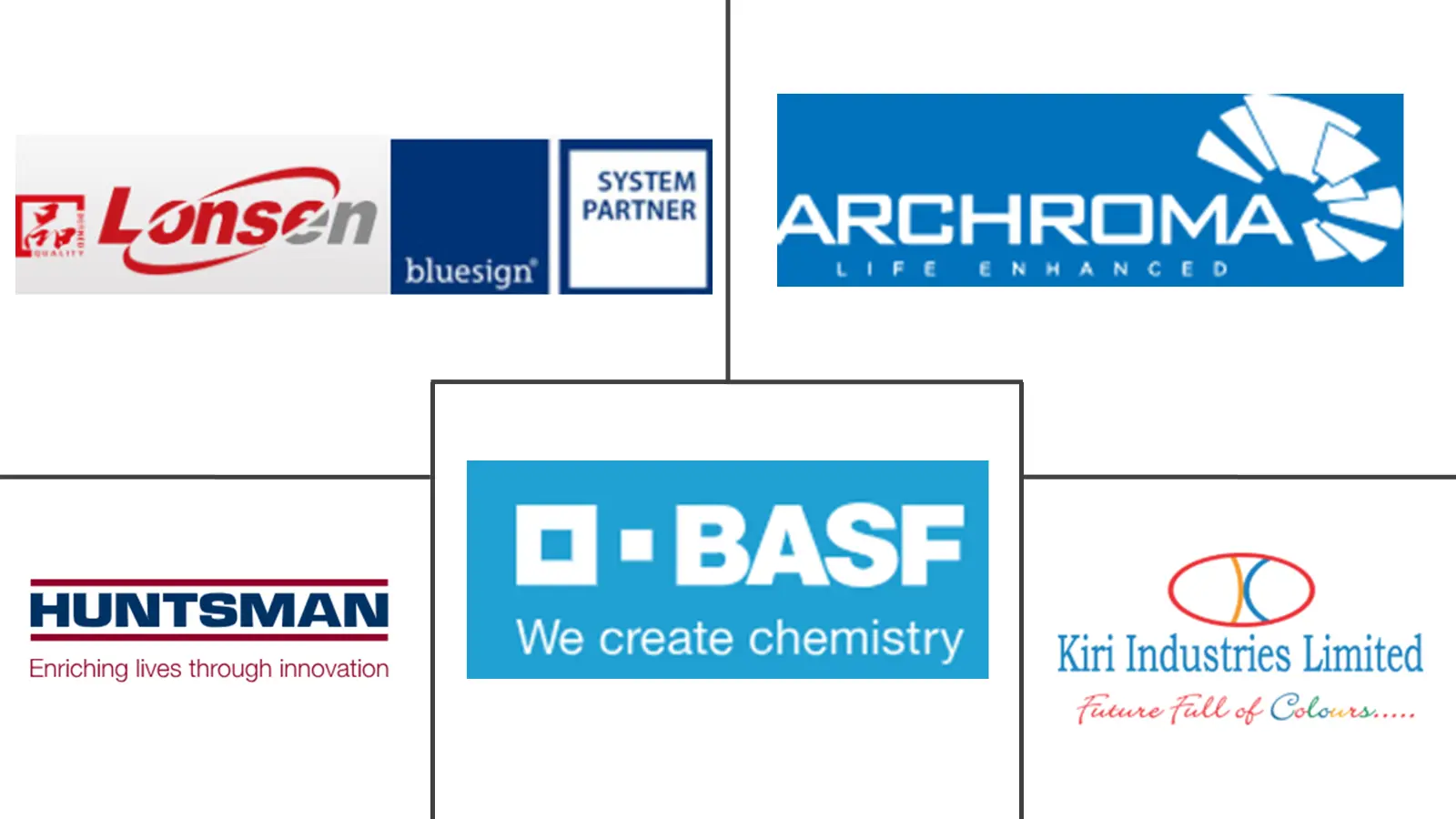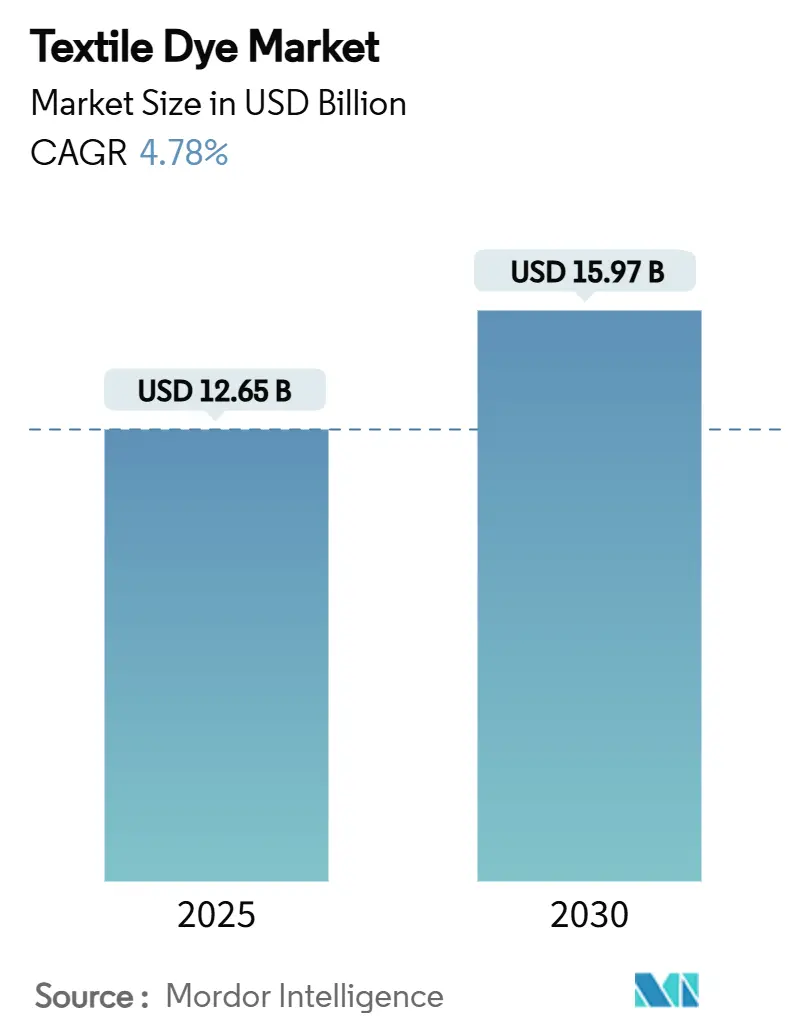
Textile Dye Market Analysis by Mordor Intelligence
The Textile Dye Market size is estimated at USD 12.65 billion in 2025, and is expected to reach USD 15.97 billion by 2030, at a CAGR of 4.78% during the forecast period (2025-2030). Rising fast-fashion output, wider adoption of on-demand digital printing, and stricter brand sustainability targets are strengthening demand across both natural and synthetic colorant systems, while ongoing consolidation gives large suppliers the scale needed to invest in lower-impact chemistries. Dispersive formulations, prized for polyester processing, held the largest dye-type share at 32.08% in 2024 and continue to benefit from high-temperature application efficiency. Asia-Pacific remains the production hub: supportive government programs in China, India and Vietnam converge with e-commerce-led small-lot orders to keep capacity additions brisk. At the same time, EU and US effluent rules are accelerating the shift toward closed-loop systems and bio-based shades, creating near-term opportunities for suppliers able to certify greener chemistries under future Digital Product Passport requirements.
Key Report Takeaways
- By dye type, dispersive grades led with 32.08% revenue share in 2024 and are expanding at a 5.59% CAGR through 2030.
- By fiber, polyester captured 50.10% of the textile dyes market share in 2024, while cotton-focused formulations trail with steady single-digit growth.
- By application, apparel commanded 55.15% share of the textile dyes market size in 2024 and is projected to grow 5.14% CAGR to 2030.
- By geography, Asia-Pacific held 49.82% share in 2024 and is forecasted to register the fastest 5.71% CAGR through 2030.
Global Textile Dye Market Trends and Insights
Driver Impact Analysis
| Driver | (~) % Impact on CAGR Forecast | Geographic Relevance | Impact Timeline |
|---|---|---|---|
| Soaring fast-fashion output in emerging economies | +1.2% | Asia-Pacific, Latin America | Medium term (2-4 years) |
| Expansion of on-demand digital textile printing | +1.5% | Global; early gains in China, India, Europe | Short term (≤ 2 years) |
| Growth in technical & protective textile usage | +0.8% | North America, Europe, Asia-Pacific core | Long term (≥ 4 years) |
| Retail brand sustainability mandates (bio-based dyes) | +0.9% | Europe, North America, spill-over to Asia-Pacific | Medium term (2-4 years) |
| E-commerce-led rise in small-lot apparel orders | +0.6% | Global, concentrated in urban markets | Short term (≤ 2 years) |
| Source: Mordor Intelligence | |||
Soaring Fast-Fashion Output in Emerging Economies
Fast-fashion brands have shortened collection cycles and pushed mills in China, India and Vietnam to integrate high-speed dyeing and finishing lines that meet quality expectations at volume; China alone seeks 70% digitalization of its textile businesses by 2025. Indian production-linked incentives and new integrated parks allocate INR 726 crore for combined weaving, printing and dyeing assets that trim raw-material imports and tighten response times to consumer trends. Vietnam, targeting USD 48 billion in textile exports by 2025, is scaling cost-effective polyester programs that favor dispersive chemistries capable of rapid color changeovers to serve global buyers.
Expansion of On-Demand Digital Textile Printing
Eliminating screens, plates and excess liquor, digital equipment supports vivid short-run designs and drops water use by as much as 95% compared with rotary workflows[1]Alchemie Technology, “Digital Textile Printing – Sustainability at Scale,” alchemietechnology.com. The textile dyes market is therefore seeing incremental demand for high-purity, micro-encapsulated dispersive and reactive inks that jet reliably at industrial speeds. Automotive and aerospace makers have joined apparel brands in piloting digitally printed technical textiles that require exact color matches and minimal weight gain, a niche previously underserved by traditional batch dyeing.
Growth in Technical & Protective Textile Usage
Defense procurement in North America and Europe specifies UV-Visible-IR camouflage fabrics whose reflectance windows shift across threat environments; achieving those targets often requires multi-stage processes blending vat, disperse and thermochromic dyes. Meanwhile, automotive seat suppliers are trialing wool/PA56 blends that accept acid shades at lower temperatures, improving energy efficiency while retaining abrasion resistance. Healthcare users are incorporating natural pigments bound to nanosilver for antimicrobial drapes that pass ISO 18184 testing against multidrug-resistant organisms.
Retail Brand Sustainability Mandates Drive Bio-Based Dye Adoption
Global consumer companies now rank colorant provenance alongside fiber traceability; several mass-market labels require a defined percentage of bio-based shades by 2027. Fermentalg’s micro-algae-derived blue, pending FDA approval, exemplifies how biotech routes can displace petroleum intermediates in the textile dyes market. Parallel efforts to commercialize pigment extractions from roots and anthocyanin-rich fruit by-products position plant-based sources for wider scale as stabilizing technologies mature.
Restraints Impact Analysis
| Restraint | (~) % Impact on CAGR Forecast | Geographic Relevance | Impact Timeline |
|---|---|---|---|
| Tightening global effluent discharge norms | -0.7% | Global; stricter in EU & North America | Medium term (2-4 years) |
| Volatility in petro-derived dye intermediates | -0.5% | Global; acute in import-dependent regions | Short term (≤ 2 years) |
| Competitive threat from naturally-colored cotton | -0.3% | Niche markets in Europe, North America | Long term (≥ 4 years) |
| Source: Mordor Intelligence | |||
Tightening Global Effluent Discharge Norms
The EU Ecodesign regulation prioritizes textiles in its 2025-2030 workplan, compelling mills to document chemical inputs, extend product life and recover fibers, with PFAS bans in France reinforcing the policy push[2]OEKO-TEX Association, “France Adopts PFAS Ban in Textiles,” oeko-tex.com. California’s SB 707 similarly obliges US producers to finance end-of-life collection, adding cost pressure until closed-loop infrastructure matures.
Volatility in Petro-Derived Dye Intermediates
Crude swings raised synthetic-fiber costs 15% between 2022 and 2024 and pushed reactive-dye precursors higher, squeezing mills that already operate on single-digit margins. Though cotton prices softened, the unpredictability complicates hedging strategies, encouraging some buyers to diversify into bio-routes less tied to fossil inputs.
Segment Analysis
By Dye Type: Dispersive Dyes Dominate Synthetic Applications
Dispersive chemistries accounted for 32.08% of the textile dyes market in 2024 and are forecast to rise at 5.59% CAGR through 2030 on the back of polyester’s continued popularity. Within the textile dyes market size for colorants applied to synthetics, their water-insoluble nature enables rapid diffusion at 120-130 °C, delivering bright shades and high wet-fastness. Suppliers now segment offerings into E-, SE-, S-, P- and RD-series to target leveling, sublimation or rapid batch objectives, while research into hydrazide–hydrazone azo structures promises even higher color strength at lower pH windows. Reactive systems retain critical roles in cotton, leveraging mono- and multi-anchor chemistry to achieve covalent fixation that passes home-laundry durability standards. Vat and sulfur options remain niche but indispensable where maximum light fastness is mandated, for example on workwear sold into extreme climates.
Second-generation dispersive grades also anchor the drive toward water-free routes such as super-critical CO₂ dyeing and digitally jetted high-solids inks, both prioritizing low process-liquor ratios. Combined, these innovations support broader adoption across fashion, athleisure and technical textiles, reinforcing the leadership position of dispersive chemistry in the textile dyes market.
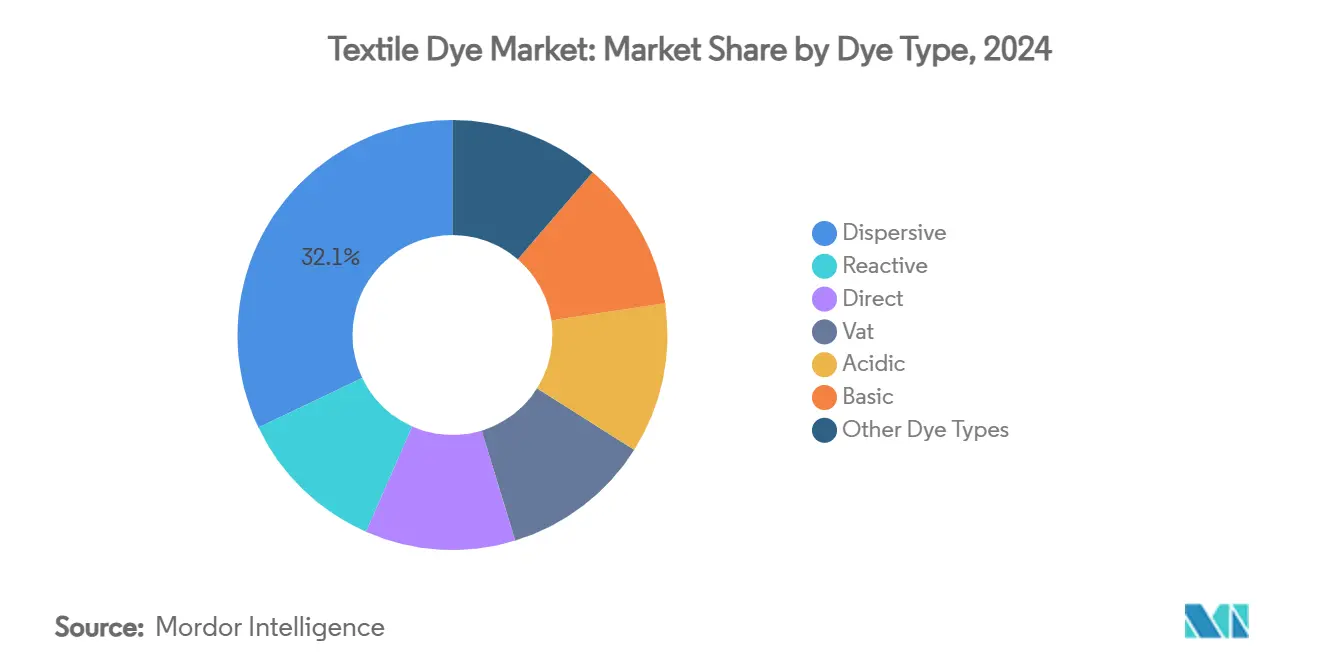
Note: Segment shares of all individual segments available upon report purchase
By Fiber Type: Polyester Leads Through Processing Advantages
Polyester held 50.10% share of the textile dyes market size tied to fiber substrates in 2024 and is projected to grow 5.34% CAGR by 2030. The polymer’s closed molecular structure demands high-temperature application, a specification that aligns perfectly with modern high-speed HT/HP jets and boosts dye uptake efficiency. Some mills have adopted cationic copolymerized polyester that introduces sulfonate groups, enabling fixation at lower temperatures and raising dye exhaustion above 90%—reducing effluent loads and saving steam. Dope-dyed yarns push sustainability further by embedding pigment in the chip, sidestepping wet processing entirely and improving shade consistency for automotive interiors and sportswear.
Cotton retains strategic importance for premium apparel but faces water-use scrutiny; here, high-reactivity reactive dyes with low salt demand have emerged, shrinking chemical oxygen demand in rinsing steps. Wool and nylon share smaller slices of the textile dyes market; nevertheless, acid and metal-complex systems remain essential to achieve vibrant hues in luxury tailoring and performance outwear, with new auxiliary blends preventing felting during rapid dyeing cycles.
By Application: Apparel Drives Market Growth
Apparel represented 55.15% of the textile dyes market in 2024, expanding at 5.14% CAGR as social-media trends, influencer drops and mass-customization programs accelerate style turnover. Dye-sublimation on polyester T-shirts and leggings allows photo-quality prints that resist cracking through countless washes, supporting a sublimated garment market set to reach USD 8.25 billion by 2030. The same on-demand infrastructure filters into athleisure, teamwear and promotional sectors, where color vibrancy and production agility can command double-digit price premiums.
Beyond clothing, home textiles are pivoting toward biodegradable natural shades free from azo precursors as consumers prioritize indoor air quality and perceive botanical colorants as safer alternatives. Technical segments—defense, automotive, medical—round out the textile dyes industry opportunity with specification-heavy programs that reward suppliers capable of tailoring multi-functional finishes alongside color, such as antimicrobial, IR-reflective or flame-retardant properties.
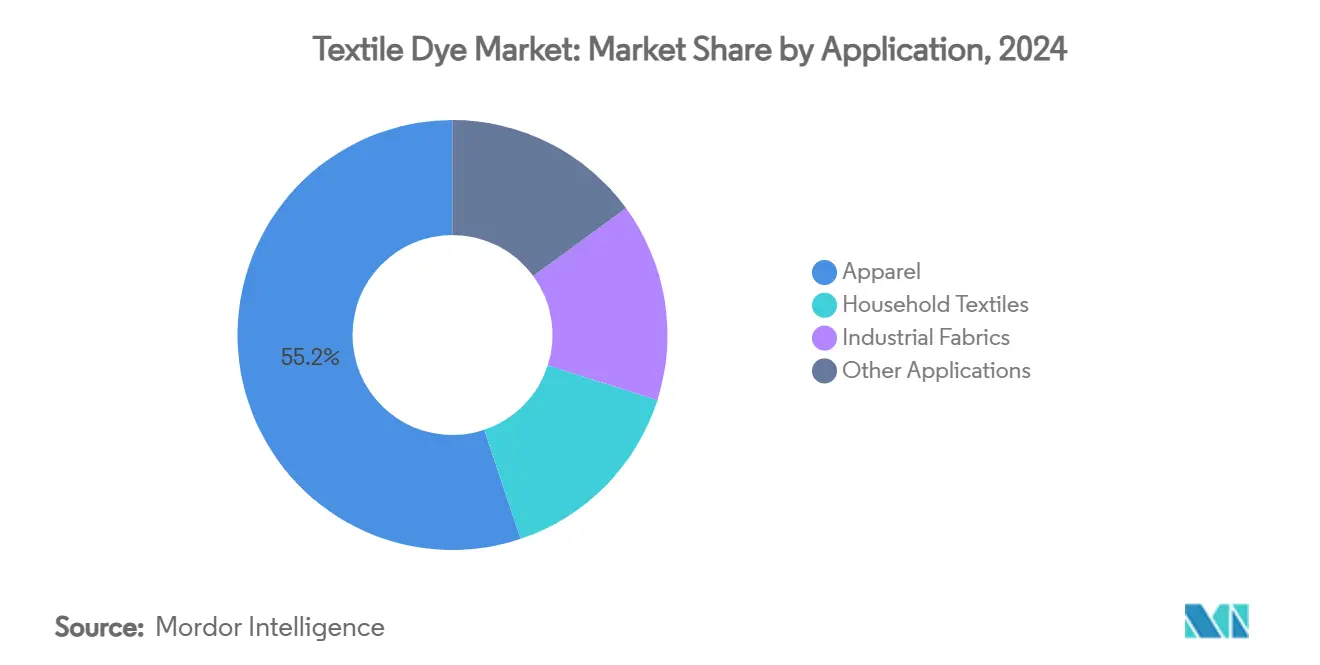
Note: Segment shares of all individual segments available upon report purchase
Geography Analysis
Asia-Pacific contributed 49.82% of the global textile dyes market in 2024 and is on track to sustain the fastest 5.71% CAGR through 2030, powered by China’s digital-factory push and India’s USD 45 billion export ambition. Government-backed parks integrate dyeing, printing and finishing to shorten supply chains, while Vietnam’s export targets intensify regional rivalry for large sportswear orders. Local access to purified terephthalic acid and mono-ethylene glycol supports dispersed-dye producers, ensuring raw-material continuity despite global shipping disruptions.
Europe’s regulatory stance reshapes demand, steering buyers toward transparent, traceable and low-hazard colorant systems. The upcoming Digital Product Passport and a PFAS-free mandate by 2030 will force mills to audit auxiliaries, invest in ion-exchange effluent treatment and adopt dope-dyed solutions that minimize downstream releases. Luxury hubs in Italy and France leverage these changes to market premium sustainably dyed collections, while Scandinavian retailers pilot take-back programs that feed mechanically and chemically recycled fibers into circular dyeing loops.
North America is moving in parallel: California’s SB 707 establishes the first US extended-producer system, catalyzing alliances such as the Selenis-Syre polyester recycling venture in North Carolina set for mid-2025 start-up. Concurrently, Archroma’s USD 750,000 South Carolina expansion underlines the reshoring trend, ensuring regional access to specialty formulations as import reliance on certain azo intermediates diminishes. While the region sits behind Asia on volume, higher added-value segments and stricter compliance requirements translate to attractive margins for innovative suppliers.
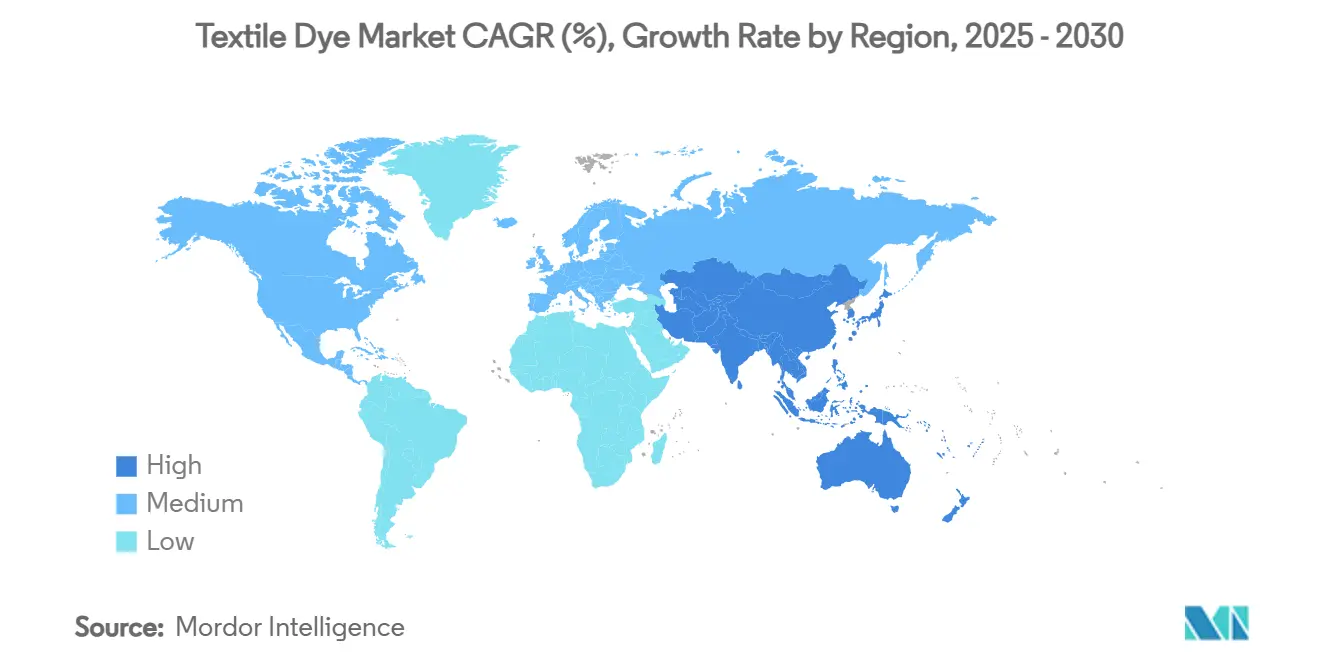
Competitive Landscape
The textile dyes market is consolidating, illustrated by Archroma’s February 2023 integration of Huntsman Textile Effects, creating a 5,000-employee platform spanning 42 countries. Scale grants the combined entity broader reach in colorant R&D, lifecycle services and digital application labs, reinforcing its ability to serve brands seeking cradle-to-gate carbon footprints and ZDHC conformance.
Competitive intensity is tilting toward technology and service differentiation rather than price alone. BASF showcased solvent-free polyamide additives at Techtextil 2024, while machinery specialist Biancalani commercialized AQUARIA washing modules that slash liquor use by 30% and integrate AI-guided recipe optimization.
White-space opportunities abound in niche, high-spec markets—airbag fabrics, e-textiles, medical dressings—where colorants must deliver performance beyond appearance. Suppliers positioned with multi-functional portfolios and robust regulatory dossiers are best placed to defend or grow share as the textile dyes market evolves under sustainability and customization pressures.
Textile Dye Industry Leaders
-
Archroma
-
Huntsman International LLC
-
Longsheng Group
-
BASF
-
Kiri Industries Ltd
- *Disclaimer: Major Players sorted in no particular order
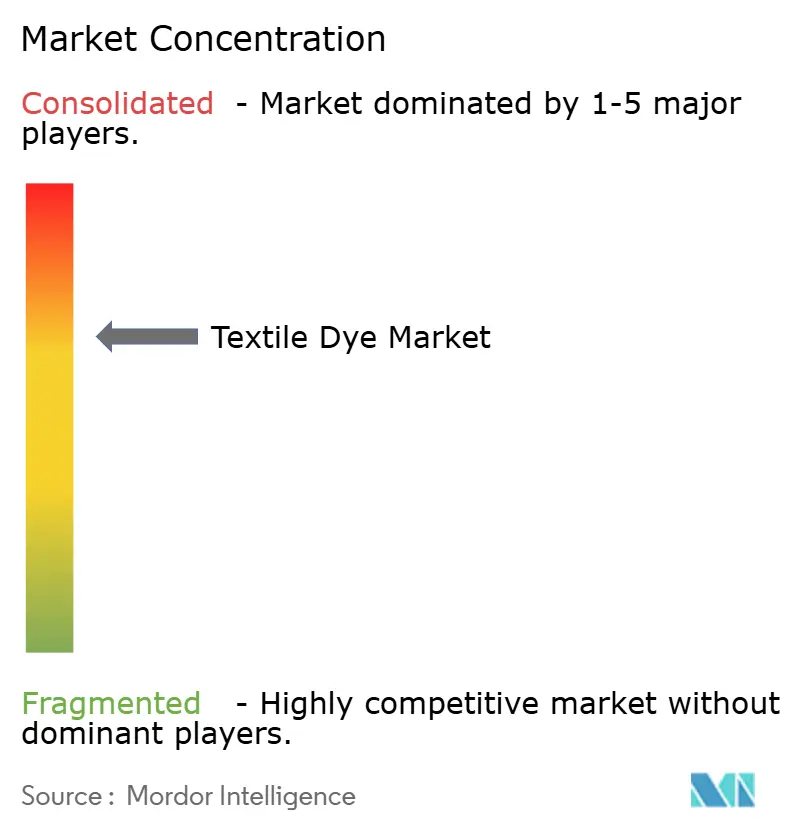
Recent Industry Developments
- April 2024: Archroma invested USD 750,000 to expand its South Carolina site, adding six jobs and boosting regional dyeing capacity.
- February 2023: Archroma completed its acquisition of Huntsman Corporation’s Textile Effects business, uniting 5,000+ staff across 42 countries under one sustainability-focused platform.
Global Textile Dye Market Report Scope
Dyes are used for coloring fabrics applied to the fiber by diffusion, absorption, or bonding. Dyes can be of two types, which include natural and synthetic dyes. Natural dyes can be derived from plants, minerals, and others. However, synthetic dyes are prepared in the laboratory. The textile dye market is segmented by dye type, fiber type, application, and geography. By dye type, the market is segmented into reactive, dispersive, direct, VAT, basic, acidic, and other dye types. By fiber type, the market is segmented into wool, nylon, cotton, polyester, viscose, acrylic, and other fiber types. By application, the market is segmented into apparel, household textiles, industrial fibers, and other applications. The report also covers the market size and forecasts for the market in 15 countries across the globe. For each segment, the market sizing and forecasts have been done based on revenue (USD million).
| Reactive |
| Dispersive |
| Direct |
| Vat |
| Acidic |
| Basic |
| Other Dye Types |
| Cotton |
| Polyester |
| Nylon |
| Wool |
| Acrylic |
| Viscose |
| Other Fiber Types |
| Apparel |
| Household Textiles |
| Industrial Fabrics |
| Other Applications |
| North America | United States |
| Canada | |
| Mexico | |
| South America | Brazil |
| Argentina | |
| Rest of South America | |
| Europe | Germany |
| United Kingdom | |
| France | |
| Italy | |
| Russia | |
| Rest of Europe | |
| Asia-Pacific | China |
| India | |
| Japan | |
| South Korea | |
| Rest of Asia-Pacific | |
| Middle East and Africa | Saudi Arabia |
| United Arab Emirates | |
| South Africa | |
| Egypt | |
| Rest of Middle East and Africa |
| By Dye Type | Reactive | |
| Dispersive | ||
| Direct | ||
| Vat | ||
| Acidic | ||
| Basic | ||
| Other Dye Types | ||
| By Fiber Type | Cotton | |
| Polyester | ||
| Nylon | ||
| Wool | ||
| Acrylic | ||
| Viscose | ||
| Other Fiber Types | ||
| By Application | Apparel | |
| Household Textiles | ||
| Industrial Fabrics | ||
| Other Applications | ||
| By Geography | North America | United States |
| Canada | ||
| Mexico | ||
| South America | Brazil | |
| Argentina | ||
| Rest of South America | ||
| Europe | Germany | |
| United Kingdom | ||
| France | ||
| Italy | ||
| Russia | ||
| Rest of Europe | ||
| Asia-Pacific | China | |
| India | ||
| Japan | ||
| South Korea | ||
| Rest of Asia-Pacific | ||
| Middle East and Africa | Saudi Arabia | |
| United Arab Emirates | ||
| South Africa | ||
| Egypt | ||
| Rest of Middle East and Africa | ||
Key Questions Answered in the Report
What is the current size of the textile dyes market?
The textile dyes market size is USD 12.65 billion in 2025 and is projected to reach USD 15.97 billion by 2030.
Which dye type holds the largest share of the textile dyes market?
Dispersive dyes lead with 32.08% share in 2024, driven by their compatibility with polyester applications.
Which is the fastest growing region in Textile Dye Market?
Asia Pacific is estimated to grow at the highest CAGR over the forecast period (2025-2030).
Why is Asia-Pacific dominant in the textile dyes market?
The region combines low-cost manufacturing, expanding digitalized mills, and supportive government programs, giving it 49.82% share in 2024 and the fastest 5.71% CAGR outlook.
How are sustainability regulations affecting dye selection?
EU Ecodesign rules, PFAS bans and US extended-producer laws are pushing brands to adopt low-hazard, bio-based or dope-dyed colorants, accelerating investment in greener chemistries.
What technologies are driving future growth in the textile dyes industry?
On-demand digital printing, super-critical CO₂ dyeing, dope-dyed yarns and AI-guided finishing systems are among the key innovations boosting efficiency and reducing environmental impact.
Page last updated on:
